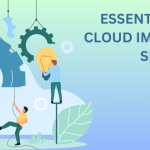In this digital era, embracing the power of Cloud computing is very important. Cloud migration is simply a process through which data, applications, or infrastructure gets migrated from data centers to a cloud. Cloud migration impacts organizations in various ways, such as by reducing costs and supporting effective performance and agility.
There are various cloud service providers in the market, and one such popular is (AWS) Amazon web service. It is one of the most preferred cloud computing platforms offering various services to help organizations migrate their current infrastructure to the client efficiently. It is said that while migrating to the cloud organization needs to take care of planning, execution, and management.
In this blog, we will talk about AWS Cloud Migration in-depth, along with the steps, strategies, and benefits of AWS Cloud Migration.
What is AWS Cloud Migration?
Amazon Web Services started offering various IT-related web-based cloud computing services in 2006. It is a cloud computing platform offered by Amazon for providing all sorts of cloud-based services, from database management to Machine learning and computing power. If your business is of any shape and size, these services are provided on a pay-as-you-go basis.
Nowadays, due to numerous benefits such as scalability, cost saving, and flexibility, demand for AWS cloud migration has risen a lot. Also, it is said that the process of each organization migrating to the cloud will be different as there is no specific size bases migration plan for all. So each migrating IT service would be different in cost, performance, and complexity, proving that you cannot move all your components to the cloud by using any single method. So it is always advisable that you plan and design a roadmap for the migration that will help answer various questions about moving components that will allow cloud migration strategies to be implemented.
AWS Cloud Migration Steps:
Now let’s talk about the Key steps needed for AWS cloud migrations:
1.Planning and assessment:
One of the first steps to move for Cloud migration is to check the current organization’s existing infrastructure to identify whether all sorts of workloads are possible to move to the cloud or not. Here in this assessment, an in-depth analysis of your organization is needed, including environment, software, hardware, etc., related to all information about your organization.
2. Designing and architecture:
Once the assessment is done, the next step is to design the cloud environment, which helps in planning the architecture of the cloud environment, which helps support an organization’s workloads. Also, in the designing process, AWS services are required to support each workload as well as plan proper network, security, and solid architecture.
3.Data Migration:
This process moves an organization’s data from its current AWS infrastructure to the cloud. From the migration plan to testing to validation, all steps are required to move the dataset and validate the migration process.
4.Application Migration:
Application migration is the process of moving organizations’ applications from the current infrastructure to the AWS cloud. It also asks for testing and validating the migrated application to check the functionality.
5.Test and validate:
So once the data and application migration is done successfully to the AWS cloud, it is time to test and validate them to the new environment to ensure everything is working correctly. Here there is also a series of tests done to validate the performance.
6.Optimization and Managing:
Once the migration is done, the step of managing and optimizing comes just to ensure that the new environment meets the need of the organization. It includes continuous monitoring and optimizing the AWS environment to improve an organization’s cloud strategy.
AWS Cloud Migration Strategies:
Basically, an Application Migration Strategy is simply a process of migrating the whole application’s environment and infrastructure. Let’s talk about some of the best AWS Cloud Migration Strategies in depth below:
1.Retire :
Once the application gets delivered in the cloud, you may think about not wanting such an application shortly because, in the longer term, it won’t be useful, and at that time, you can simply turn them off. So this process of getting rid of that application is called the retire strategy, which helps organizations save costs and boosts up the business case too.
2.Retain:
Here you may think to keep those applications just how they are before any sort of a re-evaluation happens. This retail strategy helps maintain workloads on premises with a second idea of revisiting them in some time for decision-making.
3.Re-Locate:
One of the most common AWS migration strategies is re-hosting something generally known as Lift and Shift. Here it means taking applications and moving as it is into the AWS cloud environment. This is the best plan for an organization looking for a faster and quicker cloud migration strategy. Also, most organizations consider re-hosting a priority because optimizing them later when it starts running in the AWS cloud is much easier.
4.Re-Platform:
Re-platform is popularly known as Lift and Reshape, which allows organizations to benefit from some of the best capabilities of the AWS cloud. It helps applications to get modernized without putting in the effort of rewriting codes from the base or scratch and saves time too.
5.Re-architect:
Along with Re-hosting and Re-platforming, Re- the architect is considered one of the top three AWS cloud migration strategies. It is much more rewarding for the future and future poof too. Also, dependence on custom hardware or any sort of technology platforms gets eliminated too.
6.Re-Purchase:
When planning to abandon your current software and migrate to a cloud application, it can be called Re-Purchase. One scenario is transferring software from on prime server to AWS or changing the current application with SaaS.
Why You Should Host Angular Web App in AWS Cloud-front?
List of Top AWS Cloud Migration Benefits
AWS Cloud has become a very prominent choice for those who are planning for Cloud computing. There is no doubt that AWS Cloud offers numerous benefits and is the most reliable cloud computing platform among various organizations. It offers a wide range of list of services to manage the workload efficiently.
Here are some of the AWS Cloud Migration benefits includes:
1.Security:
For every organization, security is consistently among the top priorities in cloud computing. There are chances of hacking and stealing data by malicious activities from your network, so AWS Cloud comes with various safety features which help secure your resources better. It also offers services such as Amazon GuardDuty, CloudWatch, and Amazon CloudTrail to improve your organization’s security. These all are monitoring and detecting tools taking care of malicious activities to not to occur.
2.Lesser Cost:
Rather than spending thousands of dollars installing, configuring, and managing on-premise servers, AWS allows you to run your application on the platform with zero cost. You just need to pay for the computing resource you are using. It saves your cost and lets your organization focus on the company’s growth. Check out the AWS cost optimization practices to save 40% on your AWS invoice.
3.New Technology:
Day by day AWS is making efforts to innovate to help users by offering all sorts of new and latest technologies. An organization using AWS can use various modern tools and new technology-based specifications based on their needs.
4.Flexible:
AWS platform is very flexible, allowing organizations to integrate various programming models, databases, and operating systems you know. Also, it is compatible with most coding languages, so there is no need to learn new coding and worry about data loss while migrating.
5.Easy Data access:
AWS allows organizations to offer easy data access to any employee from around the world. Here you need to set a few policies regarding access, and you can avail of this perk from anywhere in the world.
Wrapping Up:
So when it comes to cloud migration, we can say that AWS cloud migration is among the most popular picks. It offers numerous benefits to organizations to scale up the business and look for upcoming growth opportunities. We have discussed the benefits and the strategies for organization planning for AWS cloud migration. AWS migration can be challenging, but adopting it would benefit organizations more. Get in touch with C-Metric to leverage our result-oriented AWS cloud migration services and hire cloud experts from us.












Get in Touch